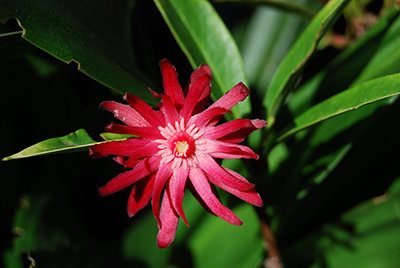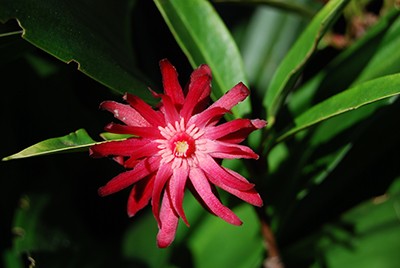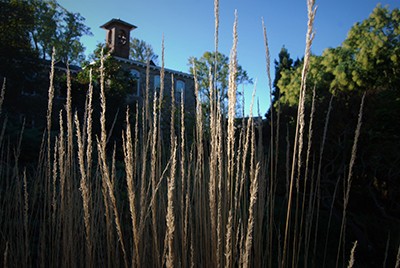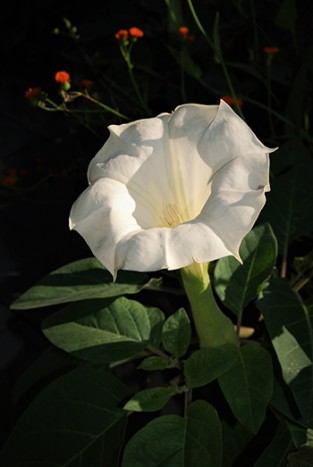
Plants of the Week: October 16
 Illicium mexicanum ‘Aztec Fire’
Illicium mexicanum ‘Aztec Fire’
Mexican anise
Hidden in plain sight at the corner of the Wister Center, this tiny Illicium mexicanum is still pumping out beautiful red blooms well into October. With the bloom time extended from spring to autumn, compared to our native Illicium which blooms only in spring, the large, red, protruding flowers of I. mexicanum can be enjoyed alongside the plump brown seed pods throughout the growing season.
Though this particular I. mexicanum ‘Aztec Fire’ at the Scott Arboretum of Swarthmore College is maybe a foot tall, this cultivar can grow to be 8 feet tall and 6 feet wide. Also known as Mexican anise, it has a natural pyramidal growth habit, contributing to its minimal need for pruning, which can be done if needed after flowering.
Planting I. mexicanum in a protected, evenly moist but well-draining area with an abundance of organic material will ensure its survival. Although best grown in full to part shade, I. mexicanum will adapt to full sun in about three years if the soil is not too dry. The evergreen, dark, shiny, green leaves smell of anise when crushed, making them an undesirable snack for deer. Photo Credit: R. Armstrong
Calamagrostis x acutiflora ‘Karl Foerster’
Feather reed grass
I’m finding myself always drawn to this plant. Maybe it’s as far out as the collective consciousness of the world persuading my emotions. Or maybe it’s as simple as we have great gardeners here at the Scott Arboretum of Swarthmore College. Either way, this plant always looks fantastic. Calamagrostis x acutiflora ‘Karl Foerster’ is the most popular of the hybrid feather reed grasses.
‘Karl Foerster’ reportedly does well in heavy clay soils, unlike many other ornamental grasses. It loves full sun with medium-wet soil. Generally, C. x acutiflora tends to produce fewer flowers and develop floppier foliage as shade increases in its location.
‘Karl Foerster’ aids in erosion control, flourishing on the banks of bodies of water. Since this grass stays below two-and a-half feet wide, it is a superb option for narrow spaces or mass grouping. Pinkish-purple flower spikes that emerge in May give this grass its height of five feet. It keeps these spikes far into winter; the entire plant can then be cut back before new shoots emerge providing year-long interest. Examples of Calamagrostis x acutiflora can be found throughout the Nason Garden. Photo Credit: R. Armstrong
Datura metel
Horn-of-plenty
Horticulturist Josh Coceano of The Scott Arboretum of Swarthmore College pulls out the self sown seedlings of Datura metel from the Entrance Garden each spring, leaving only a few to grow into mounds of showy, fragrant blooms.
Winter hardy to USDA Zone 9-10, it is best to purchase young plants from nurseries in spring or start your own seeds indoors eight weeks before last frost. Plant D. metel after all sign of frost has passed into a rich, humusy, well-drained area with full sun and regular moisture.
Commonly known as horn of plenty, this shrubby, tender annual will sprawl in the garden so it is best to leave three feet between plants. Also great in containers, plant D. metel in an area where the flower fragrance may be enjoyed. Harvest the ripe seeds to plant the following spring after the large white blooms are finished.
If D. metel is kept in a container, cut it back and overwinter indoors in a sunny window. This plant belongs to the nightshade family and all parts of it are extremely toxic, so take care when deciding to incorporate D. metel into your garden if there are pets or children around. Photo Credit: R. Armstrong







No Comments